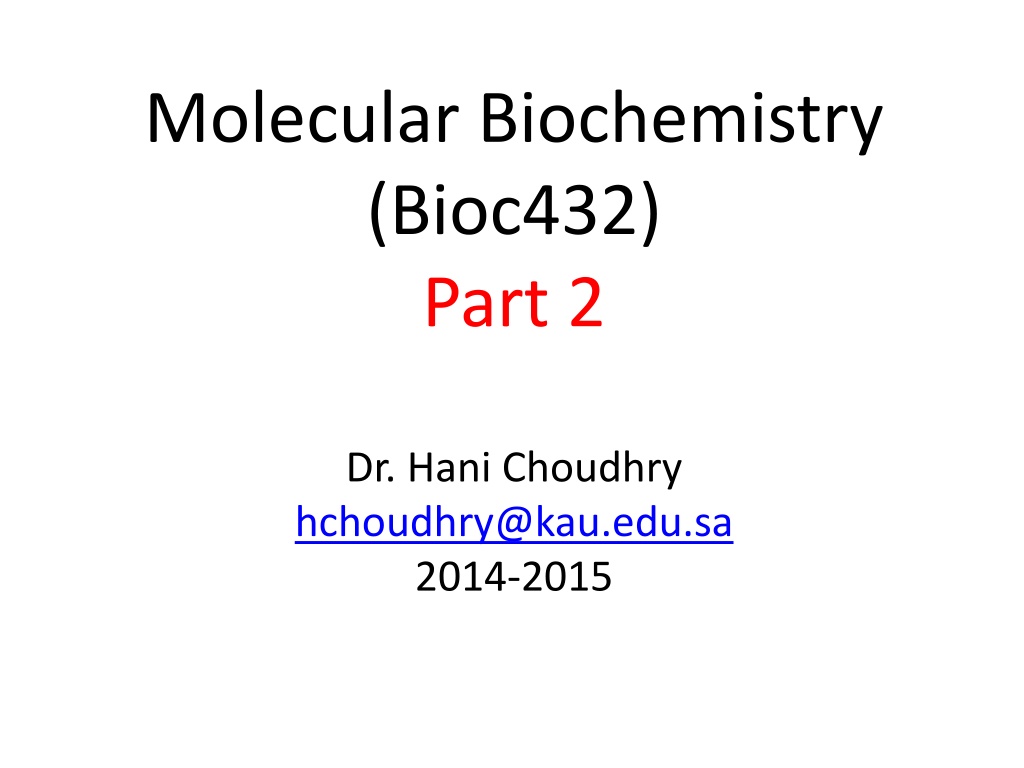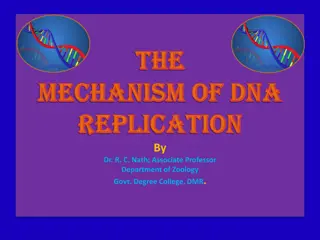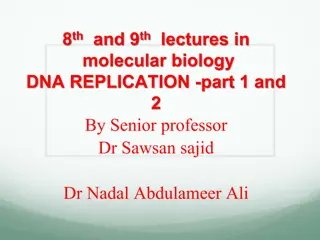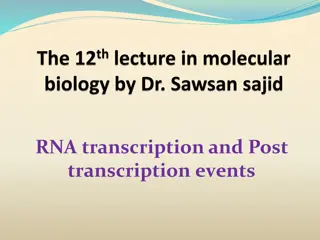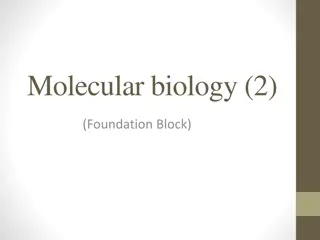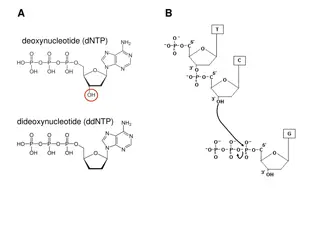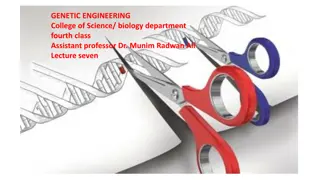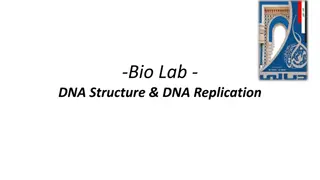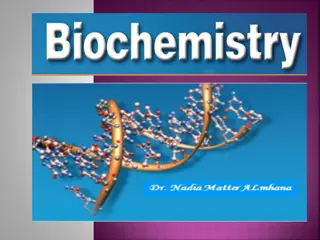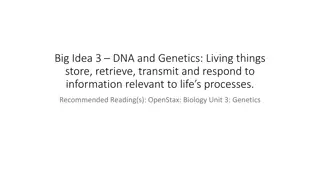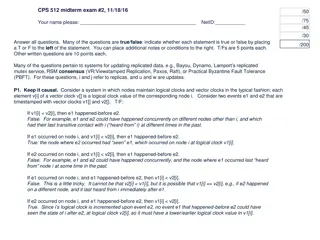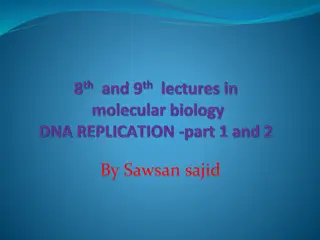Understanding DNA Replication: Models and Process Overview
DNA replication is a fundamental process where the DNA molecule unwinds and two new daughter strands are synthesized based on base-pairing rules. Three models - conservative, semiconservative, and dispersive - explain how DNA replication occurs, with each model having specific characteristics. Enzymes and proteins play crucial roles in ensuring the speed and accuracy of DNA replication.
Download Presentation

Please find below an Image/Link to download the presentation.
The content on the website is provided AS IS for your information and personal use only. It may not be sold, licensed, or shared on other websites without obtaining consent from the author. Download presentation by click this link. If you encounter any issues during the download, it is possible that the publisher has removed the file from their server.
E N D
Presentation Transcript
Molecular Biochemistry (Bioc432) Part 2 Dr. Hani Choudhry hchoudhry@kau.edu.sa 2014-2015
In DNA replication The parent molecule unwinds, and two new daughter strands are built based on base-pairing rules T T A T T A A C T T A A A G G C G G C G G C C C A A T A A T A A T T T T T T A T T A T T A A A A C C G C C G C C G G G G (a) The parent molecule has two complementary strands of DNA. Each base is paired by hydrogen bonding with its specific partner, A with T and G with C. (c) Each parental strand now serves as a template that determines the order of nucleotides along a new, complementary strand. (d) The nucleotides are connected to form the sugar-phosphate backbones of the new strands. Each daughter DNA molecule consists of one parental strand and one new strand. (b) The first step in replication is separation of the two DNA strands. Figure 16.9 a d
Type of DNA Replication Conservative Semiconservative Dispersive
First Second replication replication Parent cell Conservative model. The two parental strands associate after acting as templates for new strands, thus restoring the parental double helix. Semiconservative model. The two strands of the parental molecule separate, and each functions as a template for synthesis of a new, complementary strand. Dispersive model. Each strand of both daughter molecules contains a mixture of old and newly synthesized DNA. Figure 16.10 a c
Conservative replication: In this type, both strands of parent double helix would be conserved and the new DNA molecule would consist of two newly synthesized strands. Semi-conservative replication: In this type, out of the two strands of newly synthesized DNA, one is new and the other is retained or conserved from the original(parent) molecule. Dispersive Replication: This type involves fragmentation of the parent double helix, and intermixing of pieces of the parent strand with newly synthesized pieces, thereby forming two new double helices.
DNA replication is semiconservative Each of the two new daughter molecules will have one old strand, derived from the parent molecule, and one newly made strand
DNA Replication: A Closer Look The copying of DNA Is remarkable in its speed and accuracy More than a dozen enzymes and other proteins Participate in DNA replication
DNA - replication DNA can replicate by splitting, and rebuilding each strand. Note that the rebuilding of each strand uses slightly different mechanisms due to the 5 3 asymmetry, but each daughter strand is an exact replica of the original strand.
DNA replication steps 1:Initiation and Unwinding 2:Primer Synthesis 3:Elongation
DNA Replication 1: Initiation and Unwinding Initiation and Unwinding DNA replication occurs when the complementary strands of DNA break apart and unwind. This is accomplished with the help of enzymes called helicases. Each half will then be the template for a new, complementary strand. Because the newly unwound single strands have a tendency to rejoin, another group of proteins, the single- strandbindingproteins, keep the single strands stable until elongation begins.
DNAReplication A third family of proteins, the topoisomerases, change DNA supercoiling by inserting or removing superhelical twists. The point at which the double helix separates is called the replicationfork, because of the shape of the molecule.
DNA Replication 2:Primer Synthesis Primer Synthesis Primase enzyme starts the actual synthesis of the new DNA molecule. Primase synthesize primers (A short segment of nucleotides - about 10 to 12 bases - used to initiate DNA synthesis in the polymerase chain reaction). Primer synthesis marks the beginning of the actual synthesis of the new DNA molecule.
DNA Replication Primase are required because DNA polymerases, the enzymes responsible for the actual addition of new nucleotides to the new DNA strand, can only add deoxyribonucleotides to the 3'-OH group of an existing chain and cannot begin synthesis de novo. DNA replication can proceed only in the 5'-to-3' direction.
DNA Replication 3: Elongation Elongation At this point enzymes called DNApolymerases move along each of the separated DNA strands, adding nucleotides to the exposed bases according to the base pairing rules.
DNA Replication DNA is always synthesized in the 5'- to-3' direction, meaning that nucleotides are added only to the 3' end of the growing strand. As shown in Figure, the 5'-phosphate group of the new nucleotide binds to the 3'-OH group of the last nucleotide of the growing strand. Consequently, synthesis proceeds immediately only along the so-called leading strand. This immediate replication is known as continuous replication.
DNA Replication Synthesis of the new DNA Strands: 1. DNA Polymerase: with a RNA primer in place, DNA Polymerase (enzyme) catalyze the synthesis of a new DNA strand in the 5 to 3 direction. 5 3 5 RNA Primer DNA Polymerase Nucleotide
DNA Replication 2. Leading Strand: synthesized as a single polymer in the 5 to 3 direction. 5 3 5 RNA Primer DNA Polymerase Nucleotide
DNA Replication 3. discontinuously against overall direction of replication. Lagging Strand: also synthesized in the 5 to 3 direction, but Leading Strand 5 3 3 5 DNA Polymerase RNA Primer 3 5 5 3 5 Lagging Strand
DNA Replication 4. OkazakiFragments: series of short segments on the lagging strand. DNA Polymerase OkazakiFragment RNA Primer 5 3 5 3 LaggingStrand
DNA Replication 5. DNAligase: a linking enzyme that catalyzes the formation of a covalent bond from the 3 to 5 end of joining stands. Example: joining two Okazaki fragments together. DNA ligase Okazaki Fragment 1 Okazaki Fragment 2 5 3 3 5 Lagging Strand
How are the ends of linear chromosomes replicated ? 3 5 5 RNA Primer RNA Primer 5 3 3 5 Lagging Strand Leading strand synthesis can proceed to the end of the chromosome (top). However, DNA polymerase cannot synthesize the extreme 5 end of the lagging strand because it can only extend an RNA primer that is paired with the 3 end of a template strand (bottom). Removal of the primer and degradation of the remaining single- stranded extension would cause the chromosome to shorten with each round of replication.
